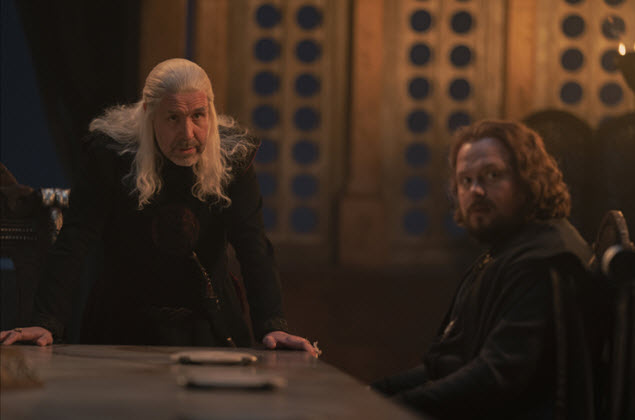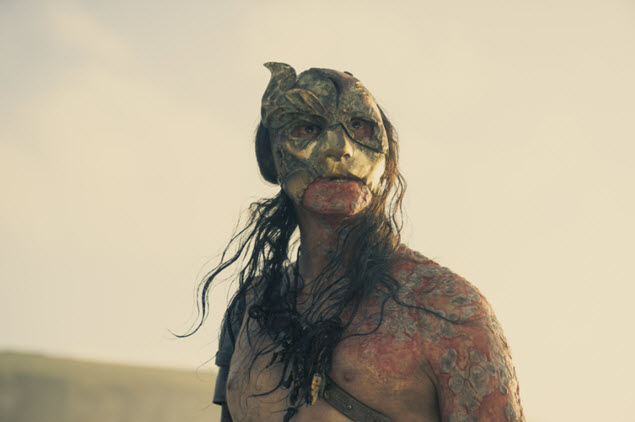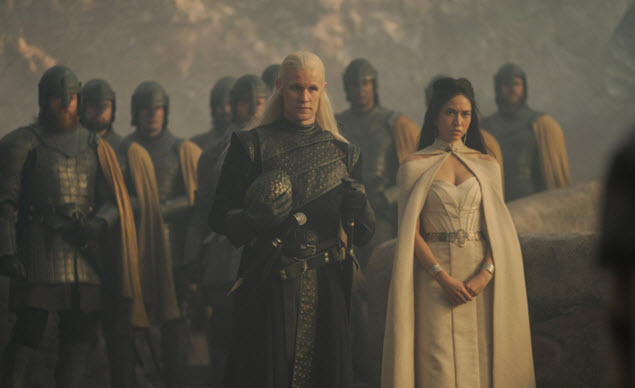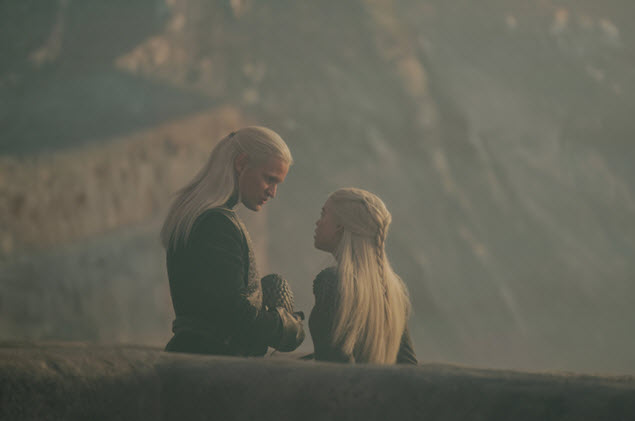Finally, my skin was itching, much like an addict suffering withdrawal from substance abuse. I couldn’t wait for the second episode of House of the Dragon to air, and boy, how good was it! I watched it with my notepad and pen resting on the arm of my lazy boy. Twenty minutes into the episode, I realized I was taking too many notes, jotting down quips before realizing they were scattered all over the episode. Every scene was significant – chunks of my notes suffered the director’s cut. I can tell you that, unlike Richard Madoc in the Netflix fantasy drama series, The Sandman, I do not need the muses to inspire me to write this review. What I will need, though, is peace of mind after publication. To rest knowing, I have included what needs to be in the final cut.
The second episode of House of the Dragon is titled “The Rogue Prince,” Unlike the premiere, we are getting opening credits on this one. The sequence opens with a higher register of the main theme of Game of Thrones.
Talking of scores and theme songs, Ramin Djawadi spoke with Entertainment Weekly a few days before the series premiere and teased what was in store for those who enjoyed the music he composed for the original show:
“I can say this much; we wanted to keep the DNA alive for House of the Dragon from the original show. We will hear themes that we remember from the original show, but because it’s all new characters, this is 200 years before, there is a ton of new material I’ve written and many new themes that we will hear.”
The opening credits for this episode unfold with a Sigil representing the Doom of Valyria. The sigil unlocks like a safety vault revealing what must be Aegon the Conqueror’s crown drenched in blood. The blood flows from Aegon to his descendants – all the way to King Viserys, symbolized by the golden crown he wears. Then to Rhaenyra, represented by the Valyrian steel necklace given to her by Daemon. The sequence culminates with the three-headed dragon sigil of House Targaryen. In my view, the blood in the opening credits could also foreshadow the destruction of House Targaryen teased in Rhaenyra’s prologues in the first episode’s opening scene.
Like the first episode, the pacing on this one was good, plot devices that needed setting were addressed, seeds were sown, and the expected time jumps were seamless. I quickly learned that it had been more than six months since Daemon’s banishment. The acting was phenomenal, and don’t get me started on the screenwriting. Off the bat, let me say this, Rhaenyra is badass. Whether the showrunners are setting me up to like her is a different matter entirely – I’m firmly in her corner, and in due time, you will also like her if you don’t already. She will earn your respect in this episode just as she did mine.
In my view, with this episode, Ryan and Miguel have solidified House of the Dragon’s place as a true successor to Game of Thrones – the main characters played the game, and they played it well. The Sea Snake moved his pieces, and so did the Hand of the King. For Lord Corlys, it is about consolidating power, protecting what he has built, and regaining what the Great Council took from his wife through his children. On the other hand, Otto is hell-bent on advancing his station by using his daughter’s maidenhood – his main agenda is to join his House to the royal line. I will admit that both are justified; the means they use to achieve their ends is what irks me. I’m fully aware this is a feudal society and that girls are significant in establishing alliances and sometimes joining families for the greater good. Before I digress, let’s take a moment to revisit my predictions in my review of the first episode.
Quick Recap
The King’s wounds are still not healing. After banishing Daemon, Viserys cut his finger on the Iron Throne. It has been over half a year, and the injury is getting worse – necrosis on the little finger. Grand Maester Mellos has resulted in using worms to feed on the dead tissue in a bid to restore life on the King’s finger. I still believe this could be happening by design or simply due to genetic mutations caused by Targaryen inbreeding. Viserys, in my opinion, is destined to have a short onscreen life though he may technically live longer due to time jumps.
In my review of episode one, I had speculated that Otto was pimping his daughter to the King to advance his station as a second son. Well, that arc has come full circle. He has succeeded, and kudos to him for playing the game. In this episode, Viserys announces his intention to marry lady Alicent. This decision, in my view, elicited feelings of betrayal in Rhaenyra and the Sea Snake, setting the ball rolling for more drama and conflict. If we learned anything from the original show is that betrayal has damning consequences – ask the Young Wolf. Red herrings are as useful as they enrich the narrative, and the screenwriter for this episode put one to great use – briefly lying to us through the eyes of Corlys and Rhaenyra that the King was about to announce his intention to marry the twelve-year-old Laena. Despite her young age, Laena was the sensible choice – duty and station demanded it. I couldn’t agree more with the Master of Laws, Lord Lyonel Strong, in his unencumbered advice to the King on the matter. Lord Strong’s advice set us up for the fall;

“Lord Corlys is your Master of Ships, and she [Laena] is the eldest daughter of the wealthiest House in the realm. She comes from unimpeachable Valyrian stock, and she has Targaryen blood. As King, you have a claim on all things, even those you don’t want. Marriage is not an obligation you can put off for long”. A little further into the conversation, Viserys wanted to know what the consequences would be if he rejected Corly’s proposal; “He would not be like to take it well. I fear nothing short of a direct line to the Iron Throne would satisfy him. You should also consider we find ourselves on the precipice of war in the Stepstones and the Sea Snake holds claim to nearly half of the realm’s ships. Driftmark makes for a better ally than it does an enemy. He has made a calculated reach, a fair play for a man of his position. Sate Lord Corlys and fix him at your side permanently as an ally.”

The Crabfeeder was teased in the first episode; the second episode wastes no time introducing him to us. The opening scene gives us a taste of the storm brewing at the Stepstones, and Craghas Drahar, the prince admiral from Myr, is the eye of this storm. Craghas serves the Triarchy – an alliance of the Free Cities Lys, Myr, and Tyrosh. Corlys was right to be concerned. Craghas has powerful entities backing his incursion, and his presence at the Stepstones is a thorn in the side of Driftmark. This incursion is not only weakening Westeros by choking trade routes; it is directly interfering with House Velaryon’s source of power. According to the Sea Snake, the King’s failures have allowed the Crabfeeder the latitude to accumulate strength. War for the Stepstones is inevitable. In Corlys’ view, a show of force from the protector of the Seven Kingdoms is necessary; otherwise, “What reason does the Crabfeeder have to fear us.”
This episode epitomized precisely what made the original show a success. The showrunners weaved a complex tapestry of drama and political intrigue. Before I digress, let me dish out what stood out for me.
Powerful and Cringeworthy Scenes
The showrunners used the opening scene of this episode to show us who Craghar was and the threat he posed. It was refreshing for me to hear Rhaenyra chime in during the Small Council meeting urging her father to respond to the incursion in the Stepstones by showing strength; “You have Dragonriders, father. Send us. It would be a show of force.” She said. Up to that point, I felt frustrated by the Small Council’s inaction or, to put it politely, over caution.

The scene at the Sept allowed me, as it did for Rhaenyra, to vent her frustration with her father and the Small Council. Hearing her speak from the heart was telling; it allowed us insight into what she truly felt about her relationship with Viserys and, at that moment, whether her father had named her heir because she deserved it. From her perspective, Viserys did not choose her – he spurned Daemon. With that, we saw the simmering tension between father and daughter. It was heartbreaking to hear her say, “I want him to see me as more than his little girl.”

Seeing Lady Laena and the King together gave made me cringe. She is twelve, for crying out loud. Uniting the two great surviving Valyrian Houses made political sense, given the crown’s vulnerability. The fact that she wouldn’t have to bed Viserys until she was fourteen did nothing to lighten the gravity of that moment. To me, Laena is still a child, though a case, on the contrary, can be made to justify the King’s choice to wed Lady Alicent, who is fifteen and by all accounts also a child. The only positive I took from the Laena and Viserys scene is the foreshadowing that Laena, despite her young age, would be Vhagar’s next Dragonrider. Let me paint this picture for you, Vhagar was ridden by Queen Visenya Targaryen during Aegon’s Conquest, alongside Aegon the Conqueror’s Balerion and their sister Rhaenys’s Meraxes. A she-dragon, Vhagar is currently the oldest of the Targaryen dragons and a hardened survivor of a hundred battles. According to Tyrion Lannister, Vhagar was large enough that one could ride a horse down her gullet.

In the next scene, we see “the Queen who never was” and Princess Rhaenyra, for the first time, having a conversation. How explosive was that scene? Both are headstrong, with dragon blood running hot in their veins. Questioning whether Rhaenyra understood the order of things, Rhaenys foreshadows Rhaenyra’s struggle for the Iron Throne;
“Whether it is to my daughter or someone else’s, your father will remarry sooner than later. His new wife will produce new heirs, and chances are better than not that one of those will be male. And when that boy comes of age, and your father has passed, the men of the realm will expect him to be heir, not you. Because that is the order of things.”
For me, that scene stood out because it drew another parallel between Rhaenyra and Daenerys Stormborn. Rhaenyra responds to the question of whether she understood the order of things by saying this;
“When I’m Queen, I will create a new order.”
That, my friends, is a callback to Daenerys’ vow to “break the wheel.” Considering the timelines, I would hazard that Daenerys in Game of Thrones channeled Rhaenyra when she sought to “break the wheel.” The screenwriters of House of the Dragon have tied a beautiful bow on this one.

I will end this segment with, in my opinion, what I consider to be the best scene of the episode – the Dragonstone confrontation. This episode is titled “The Rogue Prince,” with good reason. Daemon, having been disinherited, has taken up residence at Dragonstone, the traditional seat of the heir apparent. He has fortified his presence there with his gold cloaks for half a year. He has taken for the cradle of his “unborn” child with Mysaria, a Dragon egg, not from any clutch but one of Dreamfyre’s. The very egg that Rhaenyra had chosen for her brother, Baelon. In his letter to the Small Council, Daemon announces his intention to take Mysaria as his second wife per the traditions of Old Valyria and that she is to assume the title “Lady of Dragonstone.” The King orders Otto to assemble a small detachment and make way for Dragonstone. The mission statement is clear – recover the egg and root Daemon out of Dragonstone. Accompanying Otto is Ser Criston Cole, newly posted to the Kingsguard following the death of Lord Commander Ryam Redwyne, the new Lord Commander, Ser Harrold Westerling, Grand Maester Mellos, and the Dragonkeepers. Otto’s company is met by Daemon and a detachment of his gold cloaks on the steps of Dragonstone. When these second sons meet, I expect nothing short of a sparring session, and we get one. Caraxes turns up to put an end to this threat. Otto and his company are out of their depth until Rhaenyra arrives on the back of Syrax. Rhaenyra retrieves the egg without bloodshed but not before establishing herself as the rightful occupant of Dragonstone and heir to the Iron Throne.

“I’m right here, Uncle, the object of your ire—the reason you were disinherited. If you wish to be restored as heir, you’ll need to kill me. So, do it and be done with all this bother.”
The Blood of the Dragon Runs Thick
“This is a truly pathetic show, Daemon. Are you so desperate for the King’s attention that you’ve resorted to skulking about like a common cutpurse?” – Ser Otto
Daemon loves his brother, and I think he is acting out because he misses him. I don’t think his intention was sedition; otherwise, why would he give back the Dragon egg so easily? His mild confrontation with Rhaenyra showed his true allegiance to his family. Made of light and darkness in equal parts, Daemon’s best attributes are heightened when he is around the people he truly loves, and Rhaenyra is one of them. Talking of his love for Viserys, we all saw how he stopped Lord Corlys in his tracks when he was speaking ill of the King;
“I will speak of my brother as I wish. You will not.”
Theories and Speculation
Based on my observations in this episode, I have little to speculate. Some of the predictions I made in my episode one review have entirely played out – Otto has succeeded in his quest to get his daughter married to the King. I will, however, make the following speculations:
It will not be a smooth ride for Rhaenyra – she will fight for what is rightfully hers. This episode fell short of stating that openly. The discourse between her and “the Queen who never was” all but cemented this speculation.
“Men would sooner put the realm to the torch than see a woman ascend the Iron Throne.” – Princess Rhaenys.
My second prediction is a simple one. The showrunners sowed seeds of it in this episode, and a solid foreshadowing for it was seamless – we will see lady Laena on the back of Vhagar before the end of the first season of House of the Dragon.
Rating
The second episode of House of the Dragon has also received rave reviews from critics. It Eclipsed the premiere, drawing 10.2 million viewers across HBO and HBO Max Sunday night. Rotten Tomatoes has it at 84% and IMDB at 8.6/10. My rating for the episode is 8.5/10. The time jump was subtle, the screenwriting was excellent, and the visual effects were magnificent, particularly the Dragonstone confrontation scene, which to my surprise, was not shot on location but on set in a volume – How good is the production?
For more content on House of the Dragon, head to our in-depth article on Everything You Need to Know Before Watching House of the Dragon. You can also check out my review of episode 1 in case you missed some easter eggs in the premiere episode.
